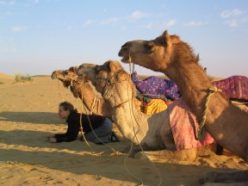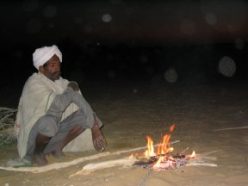News Detective: Emily Rides a Camel
I would recommend a camel trek to anyone. It’s a relaxing way to travel, except for the occasional trot, which is exciting and slightly painful. It’s also a neat way to learn about an animal that you might otherwise never have a chance to spend time with. And you get a fascinating window into an ancient way of life. People first domesticated camels more than 5,000 years ago.
 |
| Emily hangs out with some camels. |
| Annie Feidt |
My favorite part of the camel trek I took in India was the night we spent sleeping on sand dunes under the stars. Before we went to bed, two Indian men came over to share the warmth of our fire. Camels had been part of their families’ lives for many generations, they said. Now, they worked as support crew for tourists on camel treks, like ours.
Although their English was limited, we managed to get an idea of how different their lives were from ours. “All we know are camels,” said the younger man, whose name I never learned.
Both men were thin and small, with smooth dark skin and full beards. They wore long, loose nightshirt-like robes, sandals, and white turbans on their heads. Each had a blanket wrapped around his shoulders. They squatted close to the crackling fire and rubbed their hands together for warmth. “We desert people,” the man said, “always hot, cold.”
 |
| Warming up at a crackling fire. |
| E. Sohn |
The camel driver said he was 35 years old. He had been guiding tourists from around the world since he was 10. Even so, he had never even been to New Delhi, India’s capital city, about 500 miles from his home in the desert near a town called Jaisalmer. “No school, no education,” he said. “I’m scared of cities. Don’t know buses, how to get around.”
Still, he had lots of questions: Are there deserts in your country? Is it hot in your country? Are there big cities in your country?
Talking with him made me think about how my own home might seem strange to people from other countries. In the end, the trip also made a big world seem just a tiny bit smaller.